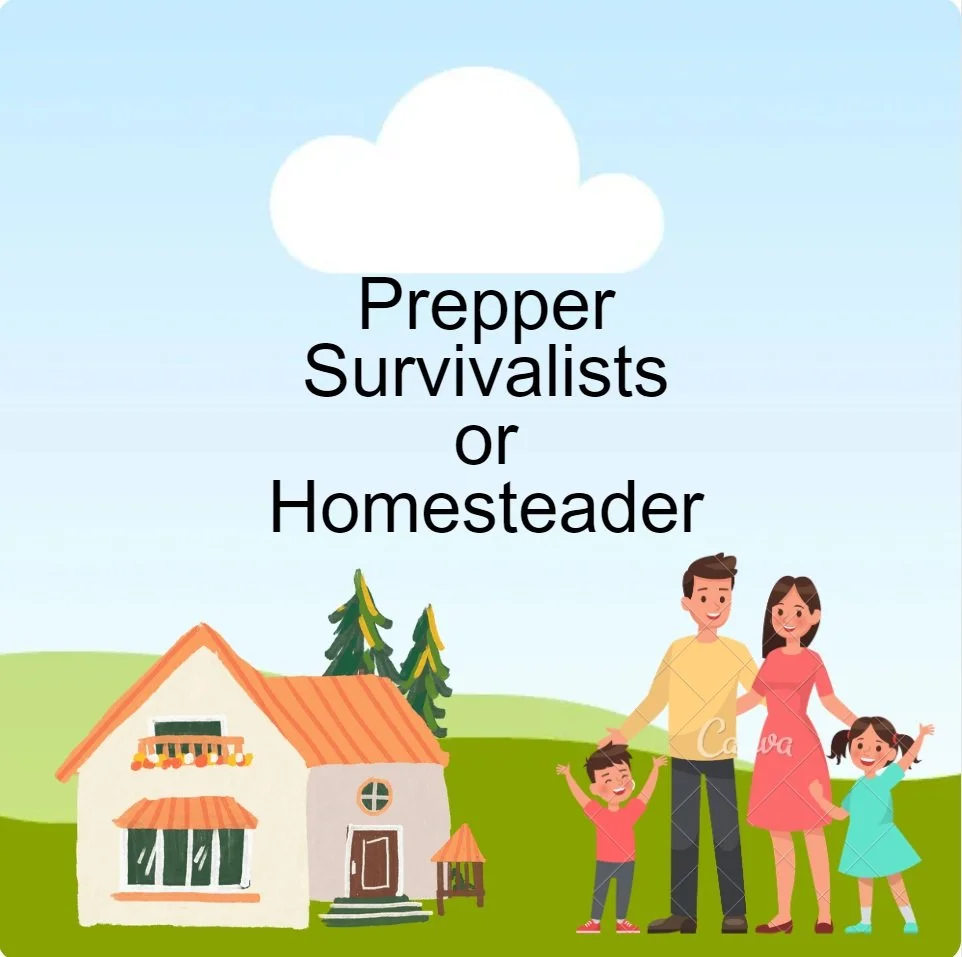Are you a Prepper?
Preppers, Survivalists, and Modern-day Homesteaders
People often inquire whether I identify as a prepper when they visit our homestead. In anticipation of sharing insights into modern-day homesteading, I thought it fitting to articulate my perspectives on these commonly used terms. Before delving into the intricacies of our homesteading journey, let's explore the distinctions between prepping, survivalism, and the unique lifestyle that is modern-day homesteading.
Preppers, survivalists, and modern-day homesteaders share some commonalities in their emphasis on self-sufficiency and preparedness, but they differ in their priorities, lifestyle choices, and long-term goals.
Prepper:
Focus on Readiness: Preppers prioritize readiness for various emergencies, disasters, or disruptions. Their preparations can include stockpiling food, water, and essential supplies to sustain them during times of crisis.
Diverse Skill Set: Preppers often acquire a diverse skill set, encompassing emergency medical skills, self-defense, and DIY capabilities. They focus on being ready to navigate a range of potential challenges.
Urban and Suburban Settings: Preppers may be found in urban or suburban settings, adapting their strategies to the limitations and opportunities presented by these environments.
Short to Mid-Term Focus: Prepping often has a short to mid-term focus, with an emphasis on surviving immediate disruptions and having the resources to endure for a certain period.
Individual or Family Focus: Prepping can be an individual or family-centric pursuit, with individuals or families taking steps to ensure their own well-being in times of crisis.
Survivalist:
Immediate Survival Skills: Survivalists emphasize immediate survival skills, such as wilderness survival, navigation, and self-defense. They are often prepared to survive in a range of environments.
Mobile Lifestyle: Survivalists may adopt a more mobile lifestyle, with the ability to move quickly in response to changing circumstances. Bug-out locations and mobility are often integral to survivalist strategies.
Minimalist Approach: Survivalists often take a minimalist approach, prioritizing essential skills and gear for survival in austere conditions.
Short-Term Focus: Survivalism is typically focused on short-term preparedness for immediate survival needs, such as natural disasters or societal breakdowns.
Modern-Day Homesteader:
Sustainable Living: Modern-day homesteaders prioritize sustainable living on a long-term basis. They aim to create a self-sufficient lifestyle that can endure for generations.
Rooted Lifestyle: Homesteaders typically adopt a more rooted lifestyle, investing in a specific piece of land where they build a home, cultivate crops, and raise livestock.
Comprehensive Self-Sufficiency: Homesteaders focus on a broader range of skills, including agriculture, animal husbandry, food preservation, and generating their energy sustainably.
Long-Term Planning: Homesteading is often centered around long-term resilience and sustainability. Homesteaders plan for a lifestyle that can endure for generations.
Community Involvement: Modern homesteaders may be more community-oriented, participating in local markets, sharing surplus produce, and engaging with neighbors collaboratively.
Examples of essential items for preppers, survivalists, and modern-day homesteaders:
Prepper:
Emergency Food and Water: Long-lasting, non-perishable food items and a supply of clean water for a specified duration.
First Aid Kit: Comprehensive medical supplies for treating injuries and addressing basic health needs.
Bug-Out Bag: A portable kit containing essential items needed to survive for a short period, including clothing, shelter, and tools.
Communication Devices: Two-way radios, emergency radios, or satellite phones for communication during disruptions.
Self-Defense Tools: Depending on local laws and personal preferences, items such as firearms, pepper spray, or other self-defense tools.
Multi-Tool: A versatile tool that combines various functions, is useful for a range of tasks.
Emergency Shelter: Compact, lightweight shelter options such as tents or tarps.
Survivalist:
Survival Knife: A versatile and durable knife for various tasks, including cutting, chopping, and preparing food.
Firestarter: Reliable methods for starting fires, such as waterproof matches, lighters, or firestarter kits.
Navigational Tools: Compass, maps, and GPS devices for navigation in different terrains.
Portable Water Filtration: Lightweight water filtration systems to purify water from natural sources.
Compact Shelter: Lightweight, portable shelter options suitable for quick setup in the wilderness.
Tactical Gear: Depending on the situation, tactical gear like camouflage clothing, durable boots, and other outdoor apparel.
Outdoor Cooking Equipment: Compact and portable cooking tools for preparing meals in the wilderness.
Modern-Day Homesteader:
Gardening Tools: Tools for cultivating, planting, and maintaining a garden, such as shovels, rakes, and hoes.
Livestock Supplies: Items for caring for and managing livestock, including feed, water troughs, and veterinary supplies.
Canning and Preserving Equipment: Tools for canning and preserving homegrown produce, such as canning jars and a pressure canner.
Solar Power Setup: Solar panels, batteries, and inverters for generating renewable energy on the homestead.
Rainwater Harvesting System: A system for collecting and storing rainwater for agricultural use.
Seed Bank: A collection of heirloom seeds for planting crops and maintaining biodiversity.
Livestock Housing: Structures such as barns or coops for sheltering and protecting animals.
These examples highlight the specific needs and priorities of each group, whether it's preparing for emergencies, surviving in the wilderness, or establishing a sustainable and self-sufficient lifestyle on a homestead.
In summary, preppers prioritize readiness for emergencies, survivalists focus on immediate survival skills and mobility, and modern-day homesteaders aim for long-term self-sufficiency and sustainability on a specific piece of land. Each group tailors its approach based on its unique goals and priorities.

